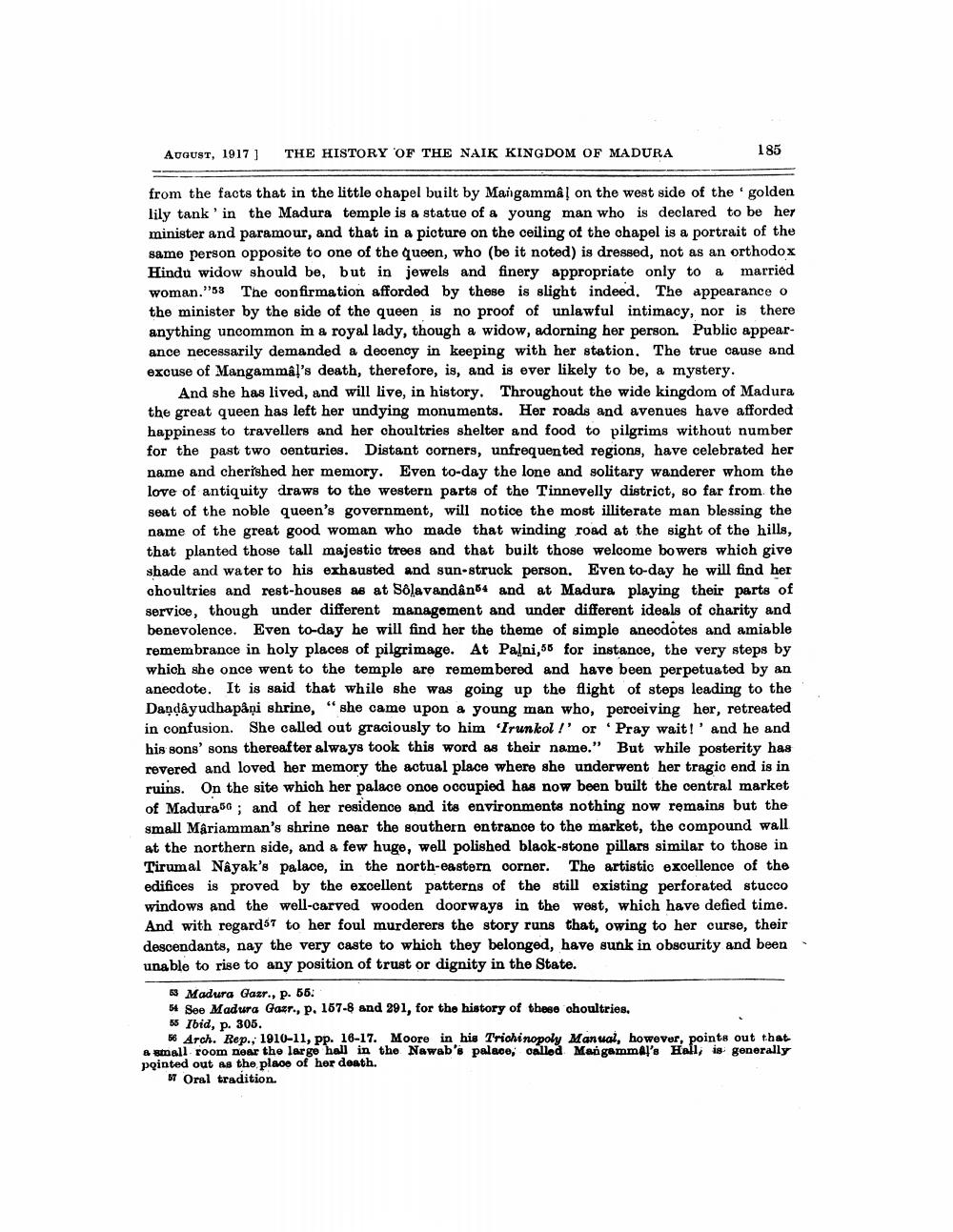________________
August, 1917)
THE HISTORY OF THE NAIK KINGDOM OF MADURA
185
from the facts that in the little chapel built by Mangammal on the west side of the 'golden lily tank' in the Madura temple is a statue of a young man who is declared to be her minister and paramour, and that in a picture on the ceiling of the chapel is a portrait of the same person opposite to one of the queen, who (be it noted) is dressed, not as an orthodox Hindu widow should be, but in jewels and finery appropriate only to a married woman."53 The confirmation afforded by these is slight indeed. The appearance o the minister by the side of the queen is no proof of unlawful intimacy, nor is there anything uncommon in a royal lady, though a widow, adorning her person. Public appearance necessarily demanded a decency in keeping with her station. The true cause and excuse of Mangammal's death, therefore, is, and is ever likely to be, a mystery.
And she has lived, and will live, in history. Throughout the wide kingdom of Madura the great queen has left her undying monuments. Her roads and avenues have afforded happiness to travellers and her choultries shelter and food to pilgrims without number for the past two centuries. Distant corners, unfrequented regions, have celebrated her name and cherished her memory. Even to-day the lone and solitary wanderer whom the love of antiquity draws to the western parts of the Tinnevelly district, so far from the seat of the noble queen's government, will notice the most illiterate man blessing the name of the great good woman who made that winding road at the sight of the hills, that planted those tall majestic trees and that built those welcome bowers which give shade and water to his exhausted and sun-struck person. Even to-day he will find her choultries and rest-houses as at SolavandânB4 and at Madura playing their parts of service, though under different management and under different ideals of charity and benevolence. Even to-day he will find her the theme of simple anecdotes and amiable remembrance in holy places of pilgrimage. At Palni,58 for instance, the very steps by which she once went to the temple are remembered and have been perpetuated by an anecdote. It is said that while she was going up the flight of steps leading to the Dandayudhapåņi shrine, "she came upon a young man who, perceiving her, retreated in confusion. She called out graciously to him 'Irunkol !' or 'Pray wait!' and he and his sons' sons thereafter always took this word as their name." But while posterity has revered and loved her memory the actual place where she underwent her tragic end is in ruins. On the site which her palace once occupied has now been built the central market of Madura50; and of her residence and its environments nothing now remains but the small Mariamman's shrine near the southern entrance to the market, the compound wall at the northern side, and a few huge, well polished black-stone pillars similar to those in Tirumal Nayak's Palace, in the north-eastern corner. The artistic exoellence of the edifices is proved by the excellent patterns of the still existing perforated stucco windows and the well-carved wooden doorways in the west, which have defied time. And with regards to her foul murderers the story runs that, owing to her curse, their descendants, nay the very caste to which they belonged, have sunk in obscurity and been unable to rise to any position of trust or dignity in the State.
53 Madura Gazr., p. 56: 54 See Madura Gazr., p. 157-8 and 291, for the history of these shoultries. 55 Ibid, p. 305.
56 Arch. Rep., 1910-11, pp. 16-17. Moore in his Trichinopoly Manual, however, points out that & small room near the large hall in the Nawab's palace, called Mangammal's Hall, is generally pointed out as the place of her death.
57 Oral tradition.




